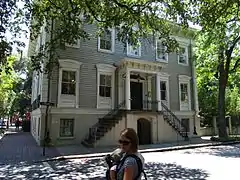James Johnston Waring
James Johnston Waring (August 19, 1829 – January 8, 1888) was a 19th-century American physician. His grandson was academic Joseph Frederick Waring.
James Johnston Waring | |
|---|---|
| Born | August 19, 1829 Savannah, Georgia, U.S. |
| Died | January 8, 1888 (aged 58) Savannah, Georgia, U.S. |
| Resting place | Laurel Grove Cemetery, Savannah, Georgia, U.S. |
| Nationality | American |
| Occupation | Physician |
| Spouse | Mary B. Alston (1856–1888; his death) |
Life and career

Waring was born on August 19, 1829, in Savannah, Georgia, to Dr. William Richard Waring and Anne Moody Johnston.[1] His mother died when he was seven; his father when he was 14.
He graduated from Yale College in 1850, followed by a master's degree from the University of Pennsylvania two years later.[2]
In early 1853, he worked in Dublin, then St Bartholomew's Hospital in London, followed by seven months in Paris. Upon his return to his native land, in 1856, he settled in Washington, D.C. He was elected 1857 Professor of Physiology, and Professor of Obstretics in the National Medical College. In 1859, he was elected surgeon and curator of the Washington Infirmary.[1]
On May 23, 1856, Waring married Mary Alston in Waccamaw, South Carolina.[1]
He held several academic posts between 1856 and 1860, before his return to his hometown of Savannah in 1861. He was appointed as a surgeon for the Provisional Army of the Confederate States in the Civil War.[1]
In 1868, Waring was expelled from the Medical Society of Savannah for "providing surety on the bonds of people of color who were charged with riotous conduct," a decision that was reversed by the Supreme Court of Georgia. It was found that the Society did no have sufficient cause for the expulsion. Waring rented property on Skidaway Island to black people so that they might learn self-dependence. He was described as a "firm friend of the colored people."[3]
Waring was practicing medicine in Savannah in 1870, living with his wife and six of their children at 3 West Perry Street in Chippewa Square.[4] The couples’ children were: Annie J. (born 1857), Mary B. (1859–1865), Pinckney Alston (1860), Helen (1862), James J. (1865), T. Pinckney (1867) and Minna A. (1869).[1]
Also in the 1870s, Mary Magdalene Marshall, a prominent Savannah citizen, appointed Waring in a codicil to her will, making him a trustee of her estate and her granddaughter Mary Marshall Barclay.[5]
When a yellow fever epidemic struck Savannah in 1876, he became chairman of a committee of the city government to carry out sanitary reform.[1]
Death
After a long illness, Waring died on January 8, 1888, aged 58. He is interred in Savannah's Laurel Grove Cemetery. His wife survived him by 27 years. She is buried in Bonaventure Cemetery.
References
- Biographical Record. 1877. p. 78.
- Georgia: Comprising Sketches of Counties, Towns, Events, Institutions, and Persons Arranged in Cyclopedic Form. State Historical Association. 1906. p. 523.
- Fraser Jr., Walter J. (2018). Savannah in the New South: From the Civil War to the Twenty-First Century. University of South Carolina Press.
- "One house and a couple of confusing Waring names". Beehive Foundation. 2018-07-03. Retrieved 2022-03-22.
- Slotin, Nancy (1974). "Mary Marshall: A Biography". Savannah Biographies.